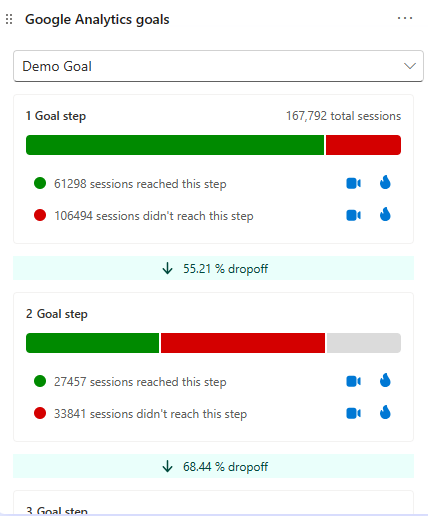Discovering What Data Is Google Analytics Goals Unable to Track
Discovering What Data Is Google Analytics Goals Unable to Track
Blog Article
Unveiling the Blind Spots: Understanding What Google Analytics Goals Can not Measure
In the world of digital analytics, Google Analytics stands as a powerful device for monitoring and analyzing on-line individual interactions. Nevertheless, in the middle of its durable capabilities, there exist blind spots that typically avert measurement. Understanding what Google Analytics goals can not gauge is essential for acquiring an extensive view of individual behavior and involvement. As we explore the details of these blind places, we uncover a complex internet of uncharted regions that hold beneficial understandings into customer actions and motivations, difficult conventional knowledge and shedding light on the limitations of our data-driven understanding.
User Behavior on External Operatings Systems
Understanding exactly how individuals connect on outside systems is vital for enhancing on the internet techniques. Exterior systems, such as social media sites networks, recommendation sites, and on-line discussion forums, play a substantial role in driving web traffic to a company's internet site. By analyzing user habits on these systems, services can gain valuable insights into the efficiency of their advertising initiatives and the preferences of their target audience.
One key facet of user actions on exterior systems is the referral source. By tracking where the customers are originating from, businesses can recognize which systems are driving one of the most traffic to their web site. This information can assist firms allocate their sources extra efficiently, focusing on the systems that produce the very best results.

Offline Interactions and conversions
Assessing user behavior on outside systems provides beneficial insights into on-line strategies; nonetheless, considering offline conversions and communications is equally crucial for a thorough understanding of a firm's general performance. Offline conversions, such as in-store purchases or phone questions, play a considerable role in many businesses' success.

Attribution Beyond Last Click
When delving right into the realm of electronic marketing analytics, it becomes vital to look beyond the single touchpoint of the last click for a much more thorough understanding of acknowledgment. While Google Analytics gives beneficial insights into customer habits, depending exclusively on last-click acknowledgment can be limiting - what data is google analytics goals unable to track. Acknowledgment versions that exceed right here the last click use a much more nuanced sight of the customer trip, considering all the touchpoints that result in a conversion
Attribution past the last click allows online marketers to assign credit scores to various interactions along the conversion path, giving a clearer image of the effectiveness of various advertising networks. By checking out multi-touch acknowledgment models such as linear, time degeneration, or position-based attribution, companies can better designate their marketing budgets and optimize their strategies for maximum effect.
Recognizing the influence of each touchpoint in the conversion procedure is important for making informed choices and taking full advantage of ROI. By accepting attribution past the last click, services can obtain much deeper understandings right into customer actions and customize their advertising efforts better.
Cross-Device and Cross-Browser Monitoring

Likewise, cross-browser monitoring enhances cross-device monitoring by recording user actions as they switch in between different web internet browsers. Comprehending exactly how customers engage with websites on numerous browsers can help online marketers optimize their on the internet experiences to make sure consistency and capability across different systems.
Qualitative Data and User Intent
Comprehending user intent with qualitative data evaluation is essential for developing targeted electronic advertising strategies that resonate with the needs and choices of the target audience. Qualitative information supplies understandings right into the 'why' behind individual actions, losing light on motivations, emotions, and choices that measurable data alone can not catch. By assessing customer feedback, remarks, and communications, marketing professionals can reveal useful information about individual intent, permitting them to tailor their messaging, material, and offerings to better line up with what their target market is seeking.
Qualitative information additionally helps in understanding the context in which customers engage with a site or application. This contextual understanding allows marketers to create more individualized and pertinent experiences, eventually driving higher interaction and conversion rates. By delving right into discover here individual intent via qualitative data evaluation, services can acquire a much deeper understanding of their target market, resulting in more effective marketing techniques that satisfy individuals' needs and expectations.
Conclusion
In verdict, Google Analytics goals have limitations in measuring individual behavior on exterior platforms, offline conversions, acknowledgment past last click, cross-device and cross-browser monitoring, and qualitative information associated with this individual intent. what data is google analytics goals unable to track. It is necessary for services to be knowledgeable about these blind places in order to supplement their data analysis with other tools and methods to obtain a much more detailed understanding of their target market and enhance their general electronic advertising methods
By examining customer actions on these systems, organizations can gain valuable understandings right into the efficiency of their marketing efforts and the choices of their target audience.
Examining customer behavior on outside platforms offers important understandings into on-line techniques; nonetheless, considering offline conversions and communications is equally necessary for a detailed understanding of a company's total performance.In electronic advertising analytics, moving past last-click attribution to discover cross-device and cross-browser monitoring is crucial for obtaining an alternative understanding of user communications throughout various systems and devices. By assessing customer feedback, remarks, and communications, marketers can discover useful information about customer intent, enabling them to tailor their messaging, material, and offerings to better align with what their audience is looking for.
By delving into customer intent via qualitative data analysis, companies can get a much deeper understanding of their target audience, leading to a lot more efficient marketing strategies that fulfill individuals' requirements and expectations.
Report this page